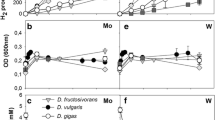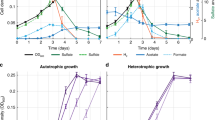Abstract
The yield coefficients forDesulfovibrio vulgaris andD. gigas varied with the electron donoracceptor combinations and with the bacterial strain. The only evidence for electron transport coupled formation of adenosine triphosphate (ATP) was with sulfate as the electron acceptor. WithD. vulgaris the ATP formation coupling to electron flow with pyruvate oxidation was 1:4 electrons and with lactate oxidation was 1:8 electrons. WithD. gigas these ratios were 1:8 electrons and 1:16 electrons for the oxidation of pyruvate and lactate. The clearest resolution of energy coupling was withD. vulgaris growing on formatesulfate medium where 2 ATP appear to be formed with the transfer of electrons from formate to adenosine phosphosulfate and one ATP with the transfer of electrons from formate to sulfite.
Similar content being viewed by others
References
Atkinson, D. E.: The energy charge of the adenylate pool as a regulatory parameter. Biochem.7, 535–554 (1968)
Baker, S., Summerson, W.: The colorimetric determination of lactic acid in biological material. J. Biol. Chem.138, 535–554 (1941)
Barton, L. L., LeGall, J., Peck, H. D., Jr.: Oxidative phosphorylation in the obligate anaerobe,Desulfovibrio gigas. In: Horizons of bioenergetics (A. San Pietro, H. Gest, eds.), pp. 33–51. New York: Academic Press 1972
Bauchop, T., Elsden, S. R.: The growth of micro-organisms in relation to their energy supply. J. Gen. Microbiol.23, 457–469 (1960)
Burton, K.: Energy of adenosine triphosphate. Nature181, 1594–1595 (1958)
Decker, K., Jungermann, K., Thauer, R. K.: Energy production in anaerobic organisms. Angew. Chem. Internat. Edit.9, 138–158 (1970)
Dickerson, R. E., Timkovich, R.: Cytochromec. In: The enzymes, Vol. XI, oxidation reduction, part A (P. D. Boyer, ed.), pp. 397–547. New York: Academic Press 1975
Forrest, W. W.: Energetic aspects of microbial growth. In: Microbial growth. Nineteenth Symposium of the Society for General Microbiology, pp. 65–86. Cambridge: The University Press 1969
Friedman, T., Haugen, G.: Pyruvic acid. II. The determination of keto acids in blood and urine. J. Biol. Chem.147, 415–443 (1943)
Grant, W.: Colorimetric microdetermination of formate. In: Methods of enzymology, Vol. 3 (S. Colowich, N. Kaplan, eds.), pp. 287–289. New York: Academic Press 1957
Gunsalus, I. C., Shuster, C. W.: Energy-yielding metabolism in bacteria. In: The bacteria, Vol. 2 (I. C. Gunsalus, R. Y. Stanier, eds.), pp. 1–51. New York: Academic Press 1961
Khosrovi, B., Miller, J. P.: A comparison of the growth ofDesulfovibrio vulgaris under a hydrogen and under an inert atmosphere. Plant Soil43, 171–187 (1975)
Lees, H.: Biochemistry of autotrophic bacteria, 112 pp. London: Butterworth 1955
LeGall, J., Postgage, J. R.: The physiology of sulfate-reducing bacteria. Adv. Microbial Physiol.10, 81–133 (1973)
Millet, J.: Degradation anaerobic du pyruvate par un extrait enzymatique deDesulfovibrio desulfuricans. Compt. Rend.238, 408–411 (1954)
Payne, W. J.: Energy yields and growth of heterotrophs. Ann. Rev. Microbiol.18, 17–49 (1970)
Peck, H. D., Jr.: The ATP-dependent reduction of sulfate with hydrogen in extracts ofDesulfovibrio desulfuricans. Proc. Nat. Acad. Sci. U.S.A.45, 701–708 (1959)
Peck, H. D., Jr.: Phosphorylation coupled with electron transport in extracts of the sulfate reducing bacterium,Desulfovibrio gigas. Biochem. Biophys. Res. Commun.22, 112–118 (1966)
Pirt, S. J.: Maintenance energy of bacteria in growing cultures. Proc. Roy. Soc. (Lond.) B163, 224–234 (1965)
Postgate, J. R.: On the nutrition ofDesulfovibrio desulphuricans. J. Gen. Microbiol.5, 714–724 (1951)
Postgate, J. R.: Recent advances in the study of the sulfatereducing bacteria. Bacteriol. Rev.29, 425–441 (1965)
Senez, J. C.: Some considerations on the energetics of bacterial growth. Bacteriol. Rev.26, 95–107 (1962)
Stouthamer, A. H.: Determination and significance of molar growth yields. In: Methods in microbiology, Vol. 1 (J. R. Norris, D. W. Ribbons, eds.), pp. 630–663. New York: Academic Press 1969
Vosjan, J. H.: ATP generation by electron transport inDesulfovibrio desulfuricans. Antonie van Leeuvenhoek. J. Microbiol. Serol.36, 584–586 (1970)
Vosjan, J. H.: Respiration and fermentation of the sulfate reducing bacteriumDesulfovibrio desulfuricans in a continuous culture. Plant Soil43, 141–152 (1975)
Author information
Authors and Affiliations
Rights and permissions
About this article
Cite this article
Magee, E.L., Ensley, B.D. & Barton, L.L. An assessment of growth yields and energy coupling inDesulfovibrio . Arch. Microbiol. 117, 21–26 (1978). https://doi.org/10.1007/BF00689346
Received:
Issue Date:
DOI: https://doi.org/10.1007/BF00689346




